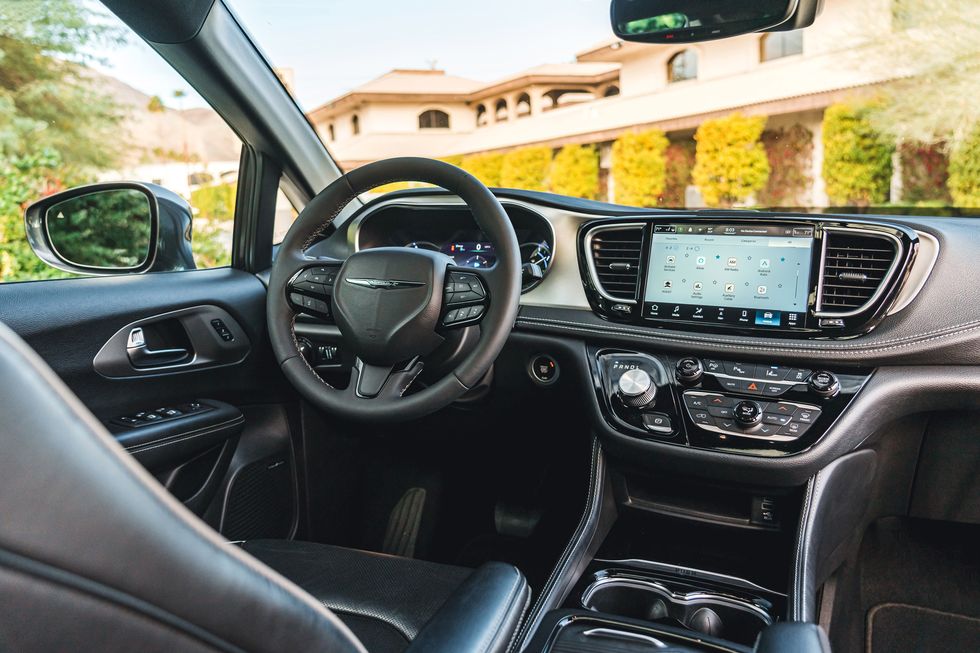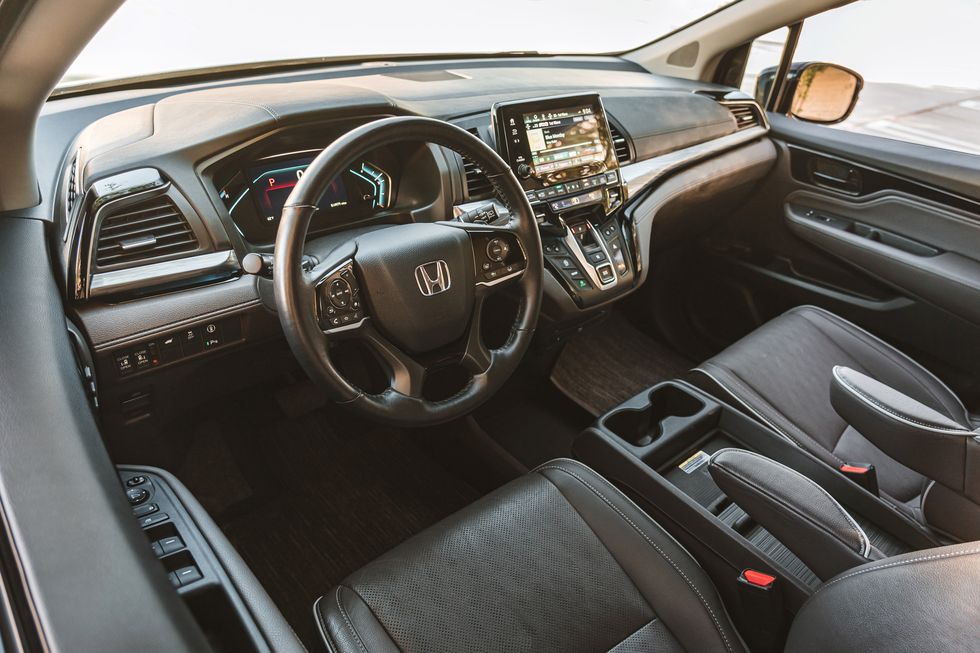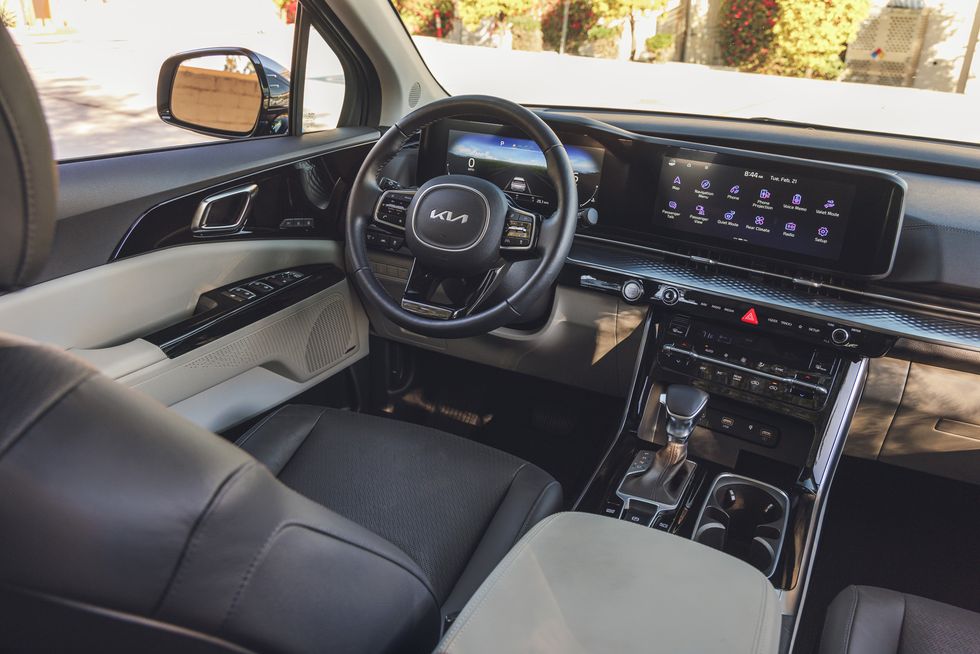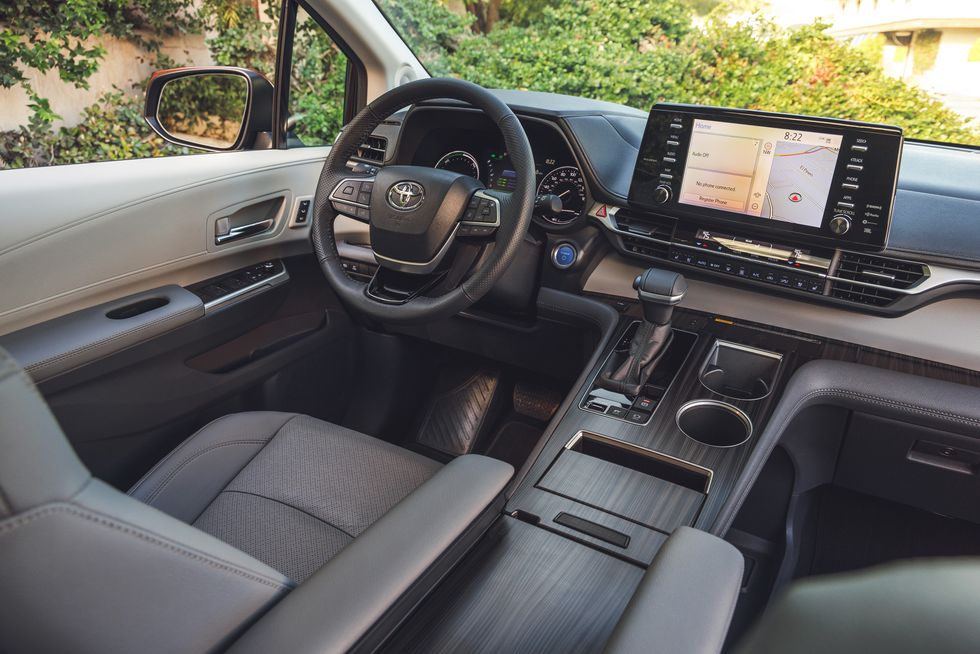Minivans Compared: Chrysler Pacifica vs. Honda Odyssey vs. Kia Carnival vs. Toyota Sienna

From the May 2023 issue of Car and Driver.
Like many a family vacation, everything was perfect when we started out. The sky was sapphire blue, Palm Springs was just closing out its fashionable Modernism Week, and we had scheduled several days of activities designed to challenge our convoy while highlighting how minivans have evolved from bare-bones people-hauling boxes to sophisticated and feature-laden luxury transports.
The plan was to soak up the February sunshine in the desert, alight through power-sliding doors in the valet drop-off at hip farm-to-table eateries, and test the sturdiness of the many cupholders on the twisting roads surrounding the valley. Then there was a sandstorm, a windstorm, a wildfire, a power outage, a canceled hotel, and a blizzard, all within the first 36 hours. It was decidedly not luxurious, but you only really appreciate the comfort and entertainment value of a minivan when you’re huddled in the back during a surprise hailstorm. If only anyone had brought a portable oven, some chicken wings, and a few DVDs of Chevy Chase movies, we would have been all set for the night. (Yes, DVDs are still a thing.)
Marc Urbano|Car and Driver
There was a time when a minivan comparison could have featured half a dozen slant-nose, sliding-door, three-row crates, all with V-6 engines, front-wheel drive, and similar prices. These days, the minivan is a vanishing art form, and those that remain have branched out with electrified drivetrains, all-wheel drive, and wildly variable price points from the $35,000 range all the way up to nearly twice that amount. We ended up with a plug-in-hybrid Chrysler Pacifica Limited, a Kia Carnival SX Prestige trying to pass for an SUV, a hybrid Toyota Sienna Limited with all-wheel drive, and an old-school underdog, the Honda Odyssey Elite. All were the top trims or close to it and loaded with options to best represent the plush, pampering offerings of Minivandia.
We were diverted from our original route, but we pulled together a passable substitute around the strange shantytowns of the Salton Sea and through the sweeping roads and rock formations of Borrego Springs. We drove on a beach of fish bones and stopped for lunch in a dive bar boasting the lowest burger in the Western Hemisphere (223 feet below sea level). With their comfy seats, big screens, and connectivity, the minivans made it easy to rework our plans on the fly. It was not the trip we envisioned, but perhaps it was a better test of how these family cars satisfy when the family vacation doesn’t.
4th Place: Chrysler Pacifica
This may come as a surprise. The Pacifica has done well in previous minivan match-ups. It’s made numerous appearances on our 10Best list, and its quilted nappa leather interior in the Pinnacle trim, with the color-matched lumbar pillows, was the inspiration for this attempted luxury-van excursion. It’s like an S-class for seven! The problem was our test van wasn’t the Pinnacle trim, so we didn’t get the fancy cushions, and it was the plug-in hybrid, so we did get a ritzy price tag. Judged without Uncle Sam’s potential $7500 kickback for making an environmentally focused purchase, the Pacifica’s $60,075 as-tested sticker hung over the Chrysler throughout this comparison.
HIGHS: Tech- forward drive-train and cabin, quiet runner, spacious third row.
LOWS: Seats too hard, brakes too soft, miss-ing Stow ’n Go.
VERDICT: For $60K, get a Charger Scat Pack and squeeze every-one in.
Chrysler doesn’t put “PHEV” anywhere on the Pacifica, which is odd because it’s the only plug-in minivan, and you’d think Chrysler would want to brag about that. The Pacifica’s 3.6-liter V-6 shares motive duties with two AC motors for a combined output of 260 horsepower. There’s a lot to love about the idea of a plug-in hybrid. For the typical around-town errands a minivan spends most of its life doing, the Pacifica’s EPA-rated 32 miles of electric range mean all the school pickups and grocery runs could be gas-free, as long as you’re gentle on the accelerator. For family road trips, the Pacifica hybrid can be fueled up and treated like a nonelectrified machine. No matter the power source, the Pacifica was the quietest of our quartet with pedal pinned to the floor, with an engine note so subdued, you don’t even need the intercom option to speak with passengers in the third row.

Marc Urbano|Car and Driver
The Pacifica was the only van to offer wireless phone mirroring, which proved useful when a hotel called to cancel our reservation due to a power outage. During the brief scramble to rebook, we considered simply sleeping in the vans, but without a Stow ’n Go second row—unavailable on the hybrid since it uses that underfloor space for the battery—the hybrid Pacifica doesn’t offer the welcoming flat floor of the regular version. However, the second-row seats are easy to remove for those of us who like to haul minibikes in our minivans. We also found these seats to be better padded and more comfortable than the fold-flat versions.
Not so the plank-like front seats. The Pacifica lost points for steering that feels like pulling against a bungee cord and brakes that associate editor Austin Irwin described as “stepping in mashed potatoes.” The Pacifica was also the slowest of our vans. That, plus its squishy driving characteristics and middling interior lacking in small-item storage, left us unable to justify its lofty price point. A non-hybrid Pacifica would likely have fared better in this pack.
3rd Place: Honda Odyssey
None of our minivans are brand-new beasts, but the Odyssey, in particular, is feeling its age. This generation has been hauling kids since 2018, and everything from the wedgy exterior to the busy dashboard looks old and dull. For some, the front seats provided inadequate lumbar support, but otherwise they were a welcoming place to spend a day. Pebbled plastic makes up the surrounding trim. “This interior is 50 shades of gray and less interesting than the book—uh, I’ve been told,” said technical editor Dan Edmunds.
HIGHS: Storage smart, hauls more than people, sporty sound, surprisingly quick.
LOWS: Gray interior causes seasonal depression, dated infotainment, looks (and is) old. VERDICT: Fast, but also loud and aging.

Marc Urbano|Car and Driver
Moving back to fetishes we’re comfortable discussing, we liked the Honda’s rambunctious powertrain. While the Pacifica was subdued and the Kia and Toyota both mumbled more than growled, the Odyssey’s howling 3.5-liter V-6 and 10-speed automatic were never caught out, even during a canyon run. With 280 horsepower, the Odyssey wasn’t the most powerful van in the group, but it was the quickest at the track, knocking out a quarter-mile in 15.3 seconds. While most van owners might never bring the revs to full song and almost certainly won’t hit a drag strip, we’re still giving Honda props for offering us such a sporty soundtrack.
Lest you think we’re losing sight of what makes a minivan valuable to nonhooligans, we did notice the Honda’s useful console, which left plenty of room for passengers’ elbows and knees as well as for large diaper totes and Ziploc bags full of Cheerios. We also noted that the second row moves not just forward and back but also side to side and is easily removable, making the Honda one of the most flexible vans in terms of rear cargo and passenger options. Despite being the quickest of the four and making senior testing editor David Beard shout “VTEC!” on more than one occasion, the Honda just couldn’t overcome its age. We’ll welcome the next-generation Odyssey, which is sure to feature the brand’s latest design elements, with open arms.
2nd Place: Kia Carnival
If your family needs the sliding-door lifestyle, but you prefer to park with the SUVs, Kia sees your cool-kid hang-ups and addresses them with a minivan that doesn’t look like a minivan. The Carnival stood out for its stylish exterior design, which helps this front-wheel-drive van masquerade as a sport-utility vehicle.
The Kia was also the muscle car of the group, with a 290-hp 3.5-liter V-6 backed by an eight-speed automatic. It wasn’t the speediest in testing, but it was the only one to light up the tires when leaving a stoplight.
HIGHS: SUV styling, uncluttered interior, value pricing.
LOWS: Limited storage, cramped third row, fixed second-row seats, worst fuel economy. VERDICT: Kia makes a good minivan but an even better SUV.
Inside, you sit up high, with a large padded center console that has the best armrests. It’s one of the most spacious and modern interiors, but it also offers the least small-item storage, with no shelves, sliding drawers, or under-console pass-through.

Michael Simari|Car and Driver
Our SX Prestige had the optional VIP Seating package, which replaces the three-seat second-row bench with two reclining lounge chairs. Our team, a lazy bunch, enjoyed testing the loungeability, but we wouldn’t recommend the chairs for most buyers. Going full recline while enjoying Netflix on the entertainment system requires moving the seats all the way back, diminishing any legroom for third-row riders. Even then, it’s likely your feet will be touching the front-seat backrests. The VIP seats aren’t removable for max cargo carrying, and passengers entering and exiting the third row can’t conveniently fold them. It’s a novel concept, but better for an executive sedan than a minivan.
Just as the Pacifica suffered because of its price, the Carnival gained position for its value. We also praised its cushioned front seats, nicely weighted steering, and quiet cabin. On the road, we noted minimal body roll, a responsive engine, and good brake-pedal feel, but if not for the Carnival’s sub-$50K price point, it wouldn’t have snuck past the Honda and its more useful interior.
1st Place: Toyota Sienna
Awarding the Sienna top honors proves we look beyond physical appearance to what lies beneath. The Toyota resembles a roast chicken—all greasy drumsticks and a fatty front end. We don’t care, because a minivan’s job is to make it easy to run a million errands while caring for a variety of living creatures, and the Sienna was most comfortable across all three rows. It also respects your budget with its fuel-sipping hybrid power train—even with all-wheel drive.
HIGHS: Gas-savvy hybrid, four-wheel traction, a place for everything.
LOWS: Looks only a parent could love, sounds like a Shop-Vac, could use an infotainment update.
VERDICT: A comfy companion whether the road trip is great or a disaster.
On the spec sheet, the Toyota was at a disadvantage. Its 189-hp 2.5-liter four-cylinder and electric motors combine to produce just 245 horsepower, but its all-wheel-drive launch meant its track numbers matched the more powerful Kia’s. Its most impressive numbers, though, were in fuel economy. While the plug-in-hybrid Chrysler managed 24 mpg during our road trip, the Sienna returned 27.

Michael Simari|Car and Driver
We did complain about the droning leaf-blower engine note, but the Sienna struck the best balance for ride quality on the highway and around town. “Not floppy, not stiff,” said the test notes—just like properly cooked vegetables. The Sienna also offered the best visibility in the test, despite having the worst-quality backup camera, and there’s storage, storage everywhere.
You could keep kids’ snacks organized in one cubby, dog treats on the dash shelf, a toy basket in the pass-through, field-trip paperwork in the door pocket, and a mini bottle of prosecco in the console for when you finally get a break. Heck, with 18 cupholders, you could host a chardonnay-tasting party. The middle and rear rows offer a variety of positions, including a nice deep recline. Whether it’s after a family vacation gone wrong or just another long week of softball tournaments and emergency vet visits, you deserve a moment of luxury.
Arrow pointing downArrow pointing down
Specifications
Specifications
2022 Chrysler Pacifica Hybrid Limited
Vehicle Type: front-engine, front-motor, front-wheel-drive, 7-passenger, 4-door van
PRICE
Base/As Tested: $56,090/$60,075
POWERTRAIN
DOHC 24-valve 3.6-liter Atkinson-cycle V-6, 220 hp, 235 lb-ft + 2 AC motors, 114 and 84 hp, 231 and 92 lb-ft (combined output: 260 hp); 12.5-kWh (est.) lithium-ion battery pack; 6.6-kW onboard charger
Transmission: continuously variable automatic
CHASSIS
Suspension, F/R: struts/multilink
Brakes, F/R: 13.0-in vented disc/13.0-in disc
Tires: Nexin Npriz RH7a
235/60R-18 103H M+S
DIMENSIONS
Wheelbase: 121.6 in
Length: 204.3 in
Width: 79.6 in
Height: 70.0 in
Passenger Volume, F/M/R: 58/54/47 ft3
Cargo Volume, Behind F/M/R: 141/88/32 ft3
Curb Weight: 5094 lb
C/D TEST RESULTS
60 mph: 7.8 sec
1/4-Mile: 16.2 sec @ 89 mph
100 mph: 20.9 sec
Results above omit 1-ft rollout of 0.4 sec.
Rolling Start, 5–60 mph: 8.1 sec
Top Gear, 30–50 mph: 3.4 sec
Top Gear, 50–70 mph: 4.8 sec
Top Speed (gov ltd): 106 mph
Braking, 70–0 mph: 183 ft
Roadholding, 300-ft Skidpad: 0.79 g
C/D FUEL ECONOMY
Observed: 24 mpg
75-mph Highway Driving: 33 mpg
75-mph Highway Range: 540 mi
EPA FUEL ECONOMY
Combined/City/Highway: 30/29/30 mpg
—
2021 Honda Odyssey Elite
Vehicle Type: front-engine, front-wheel-drive, 8-passenger, 4-door van
PRICE
Base/As Tested: $50,965/$51,420
ENGINE
SOHC 24-valve V-6, aluminum block and heads, direct fuel injection
Displacement: 212 in3, 3471 cm3
Power: 280 hp @ 6000 rpm
Torque: 262 lb-ft @ 4700 rpm
TRANSMISSION
10-speed automatic
CHASSIS
Suspension, F/R: struts/multilink
Brakes, F/R: 12.6-in vented disc/13.0-in disc
Tires: Bridgestone Turanza EL4 40
235/55R-19 101H M+S
DIMENSIONS
Wheelbase: 118.1 in
Length: 205.2 in
Width: 78.5 in
Height: 69.6 in
Passenger Volume, F/M/R: 58/57/48 ft3
Cargo Volume, Behind F/M/R: 141/87/33 ft3
Curb Weight: 4599 lb
C/D TEST RESULTS
60 mph: 6.7 sec
1/4-Mile: 15.3 sec @ 94 mph
100 mph: 17.3 sec
Results above omit 1-ft rollout of 0.3 sec.
Rolling Start, 5–60 mph: 6.9 sec
Top Gear, 30–50 mph: 3.5 sec
Top Gear, 50–70 mph: 4.4 sec
Top Speed (gov ltd): 111 mph
Braking, 70–0 mph: 184 ft
Roadholding, 300-ft Skidpad: 0.76 g
C/D FUEL ECONOMY
Observed: 20 mpg
75-mph Highway Driving: 30 mpg
75-mph Highway Range: 580 mi
EPA FUEL ECONOMY
Combined/City/Highway: 22/19/28 mpg
—
2023 Kia Carnival SX Prestige
Vehicle Type: front-engine, front-wheel-drive, 7-passenger, 4-door van
PRICE
Base/As Tested: $47,565/$49,285
ENGINE
DOHC 24-valve V-6, aluminum block and heads, port and direct fuel injection
Displacement: 212 in3, 3470 cm3
Power: 290 hp @ 6400 rpm
Torque: 262 lb-ft @ 5000 rpm
TRANSMISSION
8-speed automatic
CHASSIS
Suspension, F/R: struts/multilink
Brakes, F/R: 12.8-in vented disc/12.8-in disc
Tires: Goodyear Assurance Finesse
235/55R-19 101H M+S
DIMENSIONS
Wheelbase: 121.7 in
Length: 203.0 in
Width: 78.5 in
Height: 69.9 in
Passenger Volume, F/M/R: 62/59/46 ft3
Cargo Volume, Behind F/M/R: –/87/40 ft3
Curb Weight: 4782 lb
C/D TEST RESULTS
60 mph: 7.5 sec
1/4-Mile: 15.8 sec @ 91 mph
100 mph: 19.5 sec
Results above omit 1-ft rollout of 0.3 sec.
Rolling Start, 5–60 mph: 8.0 sec
Top Gear, 30–50 mph: 3.9 sec
Top Gear, 50–70 mph: 5.2 sec
Top Speed (gov ltd): 118 mph
Braking, 70–0 mph: 191 ft
Roadholding, 300-ft Skidpad: 0.78 g
C/D FUEL ECONOMY
Observed: 19 mpg
75-mph Highway Driving: 28 mpg
75-mph Highway Range: 530 mi
EPA FUEL ECONOMY
Combined/City/Highway: 22/19/26 mpg
—
2023 Toyota Sienna Limited
Vehicle Type: front-engine, all-wheel-drive, 7-passenger, 4-door van
PRICE
Base/As Tested: $51,730/$53,855
POWERTRAIN
DOHC 16-valve Atkinson-cycle 2.5-liter inline-4, 189 hp, 176 lb-ft + 3 permanent-magnet synchronous AC motors, front: 180 hp, 199 lb-ft; rear: 54 hp, 89 lb-ft (combined output: 245 hp); 1.5-kWh (est.) nickel-metal hydride battery pack
TRANSMISSIONS, F/R
CVT/direct drive
CHASSIS
Suspension, F/R: struts/multilink
Brakes, F/R: 12.9-in vented disc/12.5-in vented disc
Tires: Goodyear Assurance Finesse
235/55R-19 101H M+S
DIMENSIONS
Wheelbase: 120.5 in
Length: 203.7 in
Width: 78.5 in
Height: 69.7 in
Passenger Volume, F/M/R: 58/58/47 ft3
Cargo Volume, Behind F/M/R: –/75/34 ft3
Curb Weight: 4811 lb
C/D TEST RESULTS
60 mph: 7.5 sec
1/4-Mile: 15.8 sec @ 88 mph
100 mph: 22.1 sec
Results above omit 1-ft rollout of 0.3 sec.
Rolling Start, 5–60 mph: 8.5 sec
Top Gear, 30–50 mph: 3.9 sec
Top Gear, 50–70 mph: 5.8 sec
Top Speed (gov ltd): 117 mph
Braking, 70–0 mph: 190 ft
Roadholding, 300-ft Skidpad: 0.78 g
C/D FUEL ECONOMY
Observed: 27 mpg
75-mph Highway Driving: 33 mpg
75-mph Highway Range: 590 mi
EPA FUEL ECONOMY
Combined/City/Highway: 35/35/36 mpg
C/D TESTING EXPLAINED
Senior Editor, Features
Like a sleeper agent activated late in the game, Elana Scherr didn’t know her calling at a young age. Like many girls, she planned to be a vet-astronaut-artist, and came closest to that last one by attending UCLA art school. She painted images of cars, but did not own one. Elana reluctantly got a driver’s license at age 21 and discovered that she not only loved cars and wanted to drive them, but that other people loved cars and wanted to read about them, which meant somebody had to write about them. Since receiving activation codes, Elana has written for numerous car magazines and websites, covering classics, car culture, technology, motorsports, and new-car reviews.



